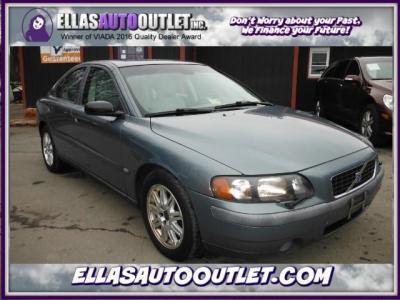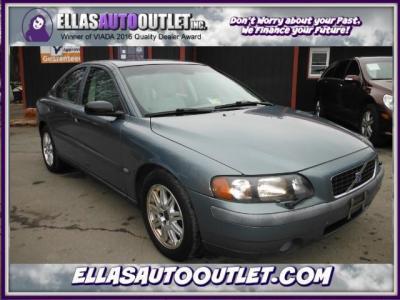
2017 Subaru Impreza 5-Door
Subaru is an odd company in many ways. One such way is its ratio of sedan to wagon sales, which is pretty much the inverse of every other manufacturer except, perhaps, Volvo. Take the Impreza, which sells at a rate of thirty percent sedans to seventy percent wagons—or “five-doors” to use the preferred industry terminology. Honda, for example, expects the fresh Civic hatchback to make up only about fifteen percent of overall Civic sales. It’s safe to say that Subaru buyers like a good hatch, and, thus, the five-door got slew of love from the engineers as part of the Impreza’s overhaul for 2017.
With a hatchback it’s all about the fuckhole, and Subaru widened the Impreza’s. The outgoing hatchback had large singular taillight clusters that, albeit big and bright, pinched the opening due to their size. So Subaru has split the taillights, putting part of the lens on the liftgate (as so many crossover designers have done before Subaru), thereby adding four inches of width to the narrowest portion of that fifth aperture. The result may look slightly generic, but it makes for lighter access to the back.
Also, the fresh Subaru Global Platform on which the Impreza is based sees its rear shock towers moved further apart by about an inch, which opens up the cargo hold. Subaru claims an extra three cubic feet of maximum cargo space in this year’s 5-Door (the company’s official name for the hatchback)—or enough to pack in eight hundred twenty seven ears of Indiana corn with the rear seats up or two thousand four hundred seventy two ears with the seats down. They actually made glued-up corn sculptures in the form of the wagon’s cargo area to prove it. Because Subaru. And because the Impreza is now made in Indiana.
Tempting as it is, we’ll leave the corn-hole jokes to lesser media outlets and just say that the Impreza 5-Door has all of the goodness that Subaru baked into its clean-sheet fresh platform, as we learned during our very first drive of the two thousand seventeen Impreza sedan. That includes better crash spectacle and a stiffer structure for improved dynamics, partially accomplished by twenty three feet of adhesive bonding plus the broader use of high-tensile “hot press” steel. As in the sedan, a revised version of the FB20 direct-injected Two.0-liter flat-four is the only engine yet available in the Impreza 5-Door; the one hundred fifty two horsepower and one hundred forty five lb-ft ratings are adequate and delivered slickly for a boxer tho’ without any neck-bending excitement. A continuously variable automatic transmission or a five-speed stick is available in all trim levels except for the loaded Limited, which is CVT-only. Manual models won’t be available originally, and five cogs is still one brief of modern norms, but Subaru (unlike Honda) gets kudos for not penalizing manual buyers by forcing them to drive a stripper.
The Impreza wagon used to be placed as sort of a puny SUV, but back in 2013, Subaru canned all the Outback-ness, pulling down the two-tone paint jobs and large fog lights and introducing the Impreza-based Crosstrek to assume the quasi-crossover role. That liberated the Impreza 5-Door to be a slick, urbane hatchback for people who might aspire to an Audi A4 Avant if that model were still sold in America. And the two thousand seventeen Impreza fills that role even better, showcasing real sophistication to its rail and treating and a better treatment of its passengers through more space plus better trim and features.
As with the sedan, the 5-Door’s fresh platform likes a 0.2-inch-lower center of gravity compared with the previous model. The curb weight, according to Subaru, ranges from about three thousand fifty pounds in the base Two.0i manual to three thousand two hundred pounds on the big-wheeled Sport. The strut front and multilink rear suspensions mounted to stiffer subframes keep chassis roll and pitch to a minimum, yet the Impreza doesn’t penalize you on cracked pavement, even on the Sport’s 18-inch wheels. A quicker steering ratio borrowed from the BRZ makes the turn-in acute and gratifying. Even in the absence of thrilling power, the Impreza is a delight because of its stiff, well-tuned chassis and also its hard brake pedal. Once you reach the freeway, the extra sound insulation and thicker side glass, as well as a redesigned HVAC system with larger ductwork and less fan roar, help cut the extraneous noise, albeit the thrumming Impreza still may not rate as the quietest in its class. (What’s that coming over the hill, is it a comparison test?)
The cockpit won’t win any The Future Is Now awards, but it does pull Subaru into the modern era with three multicolor screens upon which the latest apps can be run. Plus, there’s an optional navigation system based on TomTom software and an available rockin’ Harman/Kardon stereo. Cockpit detailing is a big step forward for Subaru’s least expensive car, and the upholstery trim gets noticeably nicer as you stir from the base Two.0i up through the Premium, Sport, and Limited trim levels.
The company says the median age of Impreza buyers is thirty two and that, industry-wide, Millennials tend to buy more sedans than hatchbacks—except when they come into a Subaru showroom, where it’s the 5-Door that the vast majority want. Why Subaru is special this way we can’t figure; the Mazda three hatchback is both practical and gorgeous but doesn’t see almost as much buyer enthusiasm. Whatever the buyers’ reasoning, with the fresh Impreza they’re getting a accurately updated car that offers both all-wheel drive and above par treating as standard equipment on cars with base prices ranging from about $20,000 to $25,500. That seems certain to keep Subaru’s amazing sales rip going for a few more years.
2017 Subaru Impreza 5-Door Very first Drive – Review – Car and Driver
2017 Subaru Impreza 5-Door
Subaru is an odd company in many ways. One such way is its ratio of sedan to wagon sales, which is pretty much the inverse of every other manufacturer except, perhaps, Volvo. Take the Impreza, which sells at a rate of thirty percent sedans to seventy percent wagons—or “five-doors” to use the preferred industry terminology. Honda, for example, expects the fresh Civic hatchback to make up only about fifteen percent of overall Civic sales. It’s safe to say that Subaru buyers like a good hatch, and, thus, the five-door got slew of love from the engineers as part of the Impreza’s overhaul for 2017.
With a hatchback it’s all about the fuckhole, and Subaru widened the Impreza’s. The outgoing hatchback had large singular taillight clusters that, albeit big and bright, pinched the opening due to their size. So Subaru has split the taillights, putting part of the lens on the liftgate (as so many crossover designers have done before Subaru), thereby adding four inches of width to the narrowest portion of that fifth aperture. The result may look slightly generic, but it makes for lighter access to the back.
Also, the fresh Subaru Global Platform on which the Impreza is based sees its rear shock towers moved further apart by about an inch, which opens up the cargo hold. Subaru claims an extra three cubic feet of maximum cargo space in this year’s 5-Door (the company’s official name for the hatchback)—or enough to pack in eight hundred twenty seven ears of Indiana corn with the rear seats up or two thousand four hundred seventy two ears with the seats down. They actually made glued-up corn sculptures in the form of the wagon’s cargo area to prove it. Because Subaru. And because the Impreza is now made in Indiana.
Tempting as it is, we’ll leave the corn-hole jokes to lesser media outlets and just say that the Impreza 5-Door has all of the goodness that Subaru baked into its clean-sheet fresh platform, as we learned during our very first drive of the two thousand seventeen Impreza sedan. That includes better crash spectacle and a stiffer structure for improved dynamics, partially accomplished by twenty three feet of adhesive bonding plus the broader use of high-tensile “hot press” steel. As in the sedan, a revised version of the FB20 direct-injected Two.0-liter flat-four is the only engine yet available in the Impreza 5-Door; the one hundred fifty two horsepower and one hundred forty five lb-ft ratings are adequate and delivered slickly for a boxer however without any neck-bending excitement. A continuously variable automatic transmission or a five-speed stick is available in all trim levels except for the loaded Limited, which is CVT-only. Manual models won’t be available primarily, and five cogs is still one brief of modern norms, but Subaru (unlike Honda) gets kudos for not penalizing manual buyers by forcing them to drive a stripper.
The Impreza wagon used to be placed as sort of a petite SUV, but back in 2013, Subaru canned all the Outback-ness, ripping off the two-tone paint jobs and large fog lights and introducing the Impreza-based Crosstrek to assume the quasi-crossover role. That liberated the Impreza 5-Door to be a slick, urbane hatchback for people who might aspire to an Audi A4 Avant if that model were still sold in America. And the two thousand seventeen Impreza fills that role even better, displaying real sophistication to its rail and treating and a better treatment of its passengers through more space plus better trim and features.
As with the sedan, the 5-Door’s fresh platform loves a 0.2-inch-lower center of gravity compared with the previous model. The curb weight, according to Subaru, ranges from about three thousand fifty pounds in the base Two.0i manual to three thousand two hundred pounds on the big-wheeled Sport. The strut front and multilink rear suspensions mounted to stiffer subframes keep chassis roll and pitch to a minimum, yet the Impreza doesn’t penalize you on violated pavement, even on the Sport’s 18-inch wheels. A quicker steering ratio borrowed from the BRZ makes the turn-in acute and gratifying. Even in the absence of thrilling power, the Impreza is a delight because of its stiff, well-tuned chassis and also its rock hard brake pedal. Once you reach the freeway, the extra sound insulation and thicker side glass, as well as a redesigned HVAC system with larger ductwork and less fan roar, help cut the extraneous noise, albeit the thrumming Impreza still may not rate as the quietest in its class. (What’s that coming over the hill, is it a comparison test?)
The cockpit won’t win any The Future Is Now awards, but it does pull Subaru into the modern era with three multicolor screens upon which the latest apps can be run. Plus, there’s an optional navigation system based on TomTom software and an available rockin’ Harman/Kardon stereo. Cockpit detailing is a big step forward for Subaru’s least expensive car, and the upholstery trim gets noticeably nicer as you stir from the base Two.0i up through the Premium, Sport, and Limited trim levels.
The company says the median age of Impreza buyers is thirty two and that, industry-wide, Millennials tend to buy more sedans than hatchbacks—except when they come into a Subaru showroom, where it’s the 5-Door that the vast majority want. Why Subaru is special this way we can’t figure; the Mazda three hatchback is both practical and gorgeous but doesn’t see almost as much buyer enthusiasm. Whatever the buyers’ reasoning, with the fresh Impreza they’re getting a scrupulously updated car that offers both all-wheel drive and above par treating as standard equipment on cars with base prices ranging from about $20,000 to $25,500. That seems certain to keep Subaru’s amazing sales rip going for a few more years.

